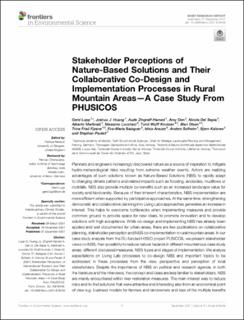| dc.description.abstract | Planners and engineers increasingly discovered nature as a source of inspiration to mitigate hydro-meteorological risks resulting from extreme weather events. Actors are realizing advantages of such solutions known as Nature-Based Solutions (NBS) to rapidly adapt to changing climate patterns and related impacts such as flooding, landslides, mudflows or rockfalls. NBS also provide multiple co-benefits such as an increased landscape value for society and biodiversity. Because of their inherent characteristics, NBS implementation are more efficient when supported by participative approaches. At the same time, strengthening democratic and collaborative planning into Living Labs approaches generates an increase in interest. This helps to overcome bottlenecks when implementing measures and provide common ground to provide space for new ideas, to promote innovation and to develop solutions with high acceptance. While co-design and implementing NBS has already been applied and well documented for urban areas, there are few publications on collaborative planning, stakeholder perception and NBS co-implementation in rural mountain areas. In our case study analysis from the EU-funded H2020 project PUSICOS, we present stakeholder views on NBS, their possibility to reduce natural hazards in different mountainous case study areas, different discussed measures, NBS types and stages of implementation. We analyze expectations on Living Lab processes to co-design NBS and important topics to be addressed in these processes from the view, perspective and perception of local stakeholders. Despite the importance of NBS on political and research agenda, in both the literature and the interviews, the concept and ideas are less familiar to stakeholders. NBS are mainly encountered within river restoration measures. The main interest was to reduce risks and to find solutions that were attractive and interesting also from an economical point of view e.g. business models for farmers and landowners and less of the multiple benefits that are most important for stakeholders in urban areas. The collaborative planning approach was seen as important for engaging stakeholders and creating knowledge about NBS. These insights will contribute to the understanding and address the management of intense stakeholder involvement processes, identify barriers that arise, and support in-depth participatory processes. | |
